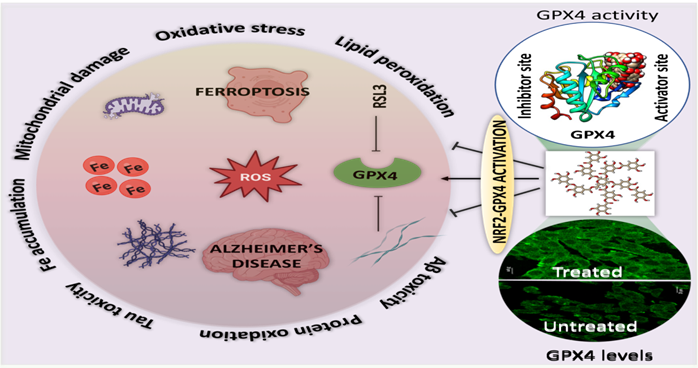
Team News Riveting
New Delhi, September 13
Scientists have found that highly abundant naturally occurring plant-based polyphenols (PPs) like tannic acid found in twigs of trees like Chestnut and Oak can modulate the ferroptosis-AD axis to yield a safe, cost-effective strategy for combating Alzheimer’s disease (AD) and reduce the societal burden of this debilitating neurodegenerative disorder.
AD is a widely prevalent progressive neurodegenerative disorder marked by memory and cognitive decline, yet it remains poorly understood despite decades of dedicated research. As a consequence of this, there is no therapeutics to completely cure the disease. Ferroptosis, an iron-dependent form of programmed cell death, has emerged as a significant contributor to the development of AD. Several hallmarks of AD, such as abnormal iron build up, lipid peroxidation, reactive oxygen species (ROS), and reduced activity of the antioxidant enzyme glutathione peroxidase 4 (GPX4), align with the characteristics of ferroptosis. GPX4, the master regulator of ferroptosis reduces toxic lipid peroxides formed by the iron-catalysed reaction of polyunsaturated fatty acids (PUFAs) with ROS to lipid alcohol and as such, acts as a first line of defence against ferroptosis. This is called the GPX4 pathway. While conventional approaches to combat ferroptosis have primarily focused on chelating iron and neutralizing ROS, the potential therapeutic strategies that target GPX4 pathway to alleviate ferroptosis in AD have remained unexplored. GPX4 protein synthesis in itself is an energetically demanding, low efficiency process, and therefore, molecules that can activate and elevate GPX4 levels might be the key to prevent oxidative stress implicated in chronic disorders.
Study by scientists of Jawaharlal Nehru Centre for Advanced Scientific Research (JNCASR), an autonomous institute of the Department of Science and Technology (DST) presents naturally occurring polyphenols (PPs) as innovative and multimodal therapeutic agent with dual capabilities to ameliorate ferroptosis and AD. The underlying mechanisms involve the inhibition of aggregation of amyloid (abnormal fibrous, proteinaceous deposits found in organs and tissues) and tau protein (abundantly found in the neurons of the central nervous system), diminishing oxidative stress, rescuing mitochondrial function, and inhibiting ferroptosis. Their study has demonstrated that the natural polyphenol, tannic acid (TA) could act as both an activator and enhancer of GPX4. This novel approach provides a conceptually advanced and comprehensive strategy for combating AD by modulating the GPX4-ferroptosis-AD axis. The ability of TA to elevate GPX4 levels even in the presence of AD pathological conditions offers exciting new avenues for targeting novel pathways in the aetiology of AD while holding promise for tackling the intricate interplay between ferroptosis and AD.
The study published in the journal Chemical Sciences which steers research toward ferroptosis inhibitors presents a new dimension for drug development. This discovery may inspire medicinal chemists to explore new and derivatives of natural compounds to enhance therapeutic efficacy against AD.
With a rationale of targeting both AD and ferroptosis concurrently, the team screened a library of natural polyphenols for their Fe-chelation and antioxidant abilities and singled out tannic acid as a multifunctional molecule exhibiting excellent potencies in all aspects, already establishing it as a potent candidate for mitigating several pathways of AD and ferroptosis. The discovery of TA as a ferroptosis inhibitor acting via both activation and enhancement of GPX4 presents an innovative and holistic strategy against AD. This has also established a mechanistic link between AD and ferroptosis, which had so far remained elusive.
The discovery of a natural polyphenol, TA as a GPX4 activator that ameliorates Aβ induced ferroptosis holds great significance and this study presents new opportunities for the synergistic inhibition of ferroptosis in AD. By unravelling the complexities of AD and ferroptosis, the research not only addresses specific neurological challenges but also contributes to scientific knowledge, validating new disease mechanism, global health, and the well-being of dementia patients while inspiring researchers to seek this alternative axis for therapeutic avenues for neurodegenerative diseases.



